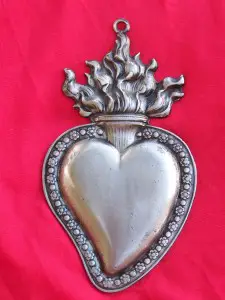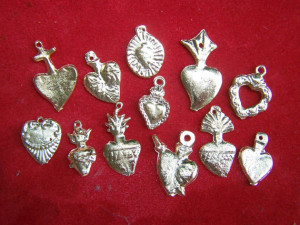Podcast: Play in new window | Download
Subscribe: Apple Podcasts | RSS
 What are Milagros?
What are Milagros?
They are small metal charms (the larger ones are called ex votos) in the form of body parts, animals, etc.
How are milagros used? The traditional way to use Milagros goes back centuries. If a faithful person has something in his or her life that seems insurmountable, he or she may “make a deal” with a saint or a virgin and ask for help. If the miracle is granted, the faithful person will follow through on his or her end of the bargain, and that may include a trip to a shrine to leave something there as a physical representation of thanks. People who have a little more money may commission a painting called an ex voto, which is usually on wood or tin, which illustrates the miracle that occurred or the favor granted. Those who can afford to part with only a few pesos will buy the metal charms that come in the shape of body parts, people, animals, plants and a wide array of inanimate objects. The milagros usually come in shapes specific to the miracle. For example, if someone wishes to give thanks for the healing of a broken arm, the devotee will purchase an arm milagro and leave it in the shrine. For a cow that recovered from illness, a cow milagro is used, and so on. The milagros are pretty literal and there are no special meanings for the individual pieces other than what is visually evident. Inside the shrine the milagros are usually left in a designated sacred space. This could either be a room off to the side, a wall or separate chapel. Often times these sacred spaces need to be “cleaned out” and the contents are usually sold by the parish to raise money for the poor. Many works of devotional art, and older or more interesting milagros end up in secondary craft markets because of this practice. Many of the little milagros for sale in the stalls outside the shrines have been used multiple times. People believe the multiple uses of these objects only give them more power.
To purchase milagros, please visit our huge variety for sale on Amazon: https://amzn.to/2XlhfOg
This traditional use of votive offerings similar to milagros dates back thousands of years to Ancient Greece. When the Roman Empire took over the Greek world, the Romans adopted the practice of leaving small gifts of thanks for the gods made out of clay, wood or metal in a symbolic form appropriate to the miracle that occurred. The Roman practice of votive offerings continued after Christianity was adopted throughout the Roman World and continued to live on in Catholic Europe for many centuries after the fall of the Roman Empire (today they are still used in parts of Spain, Portugal, France, Italy and southern Germany). As Christianity spread to the New World, milagros found new territory on which to flourish and in modern-day Latin America they are used most widely in Mexico. Today, many of the traditional shapes – arms, legs, eyes – share religious store shelf space with more modern milagros such as airplanes, cars and even computers. There is a milagro for pretty much everything, except for money, because it’s frowned upon to pray for increased wealth. To get around this, many people in Mexico use the corn milagro to symbolize abundance and prosperity and use the charm accordingly.
In an era of international trade and increased ethnic awareness in the States, milagros have become popular among Americans. Many people in the US use these small devotional objects as good luck charms much like a rabbit’s foot or a four-leaf clover. Milagros adorn charm bracelets and other pieces of folk art jewelry. Milagros are often found nailed on to crosses or covering other wooden objects like saint statues or shoes, in a purely decorative fashion. Many people who have some degree of belief that the milagros may help them, carry them or have them in their homes in anticipation of a miracle or to hope for something and not to offer thanks. They are used to focus intention or even to draw on positive energies. To traditionalists, this may seem like the opposite of the milagros’ intended use, but cultural elements always seem to adapt to new conditions when integrated into a new culture. Artists and jewelry makers have popped up on sites like etsy.com with creations like “healing charm necklaces” incorporating Mexican milagros. Creations are often elaborate and can sell for hundreds of dollars even though the cost of milagros at their manufacturing source in Mexico is often less than a nickel per piece. It’s amazing how something so small can mean so much to people who value its use.
In this podcast Robert talks about his connection to these charms: he has been importing them for sale from Mexico for almost 17 years now and for 10 of those years he had a retail store where I sold these one by one over the counter or in bulk. He has since closed the store and does everything online, but that store made him really curious as to what was going on. Customers would share their milagro experiences through face-to-face interaction in the store and by letters in the mail. Those letters requested milagros or explained know how the charms worked for the customers. Robert showed his folder of mostly hand-written letters to one older nana who used to frequent my shop said and she said, “These letters are your real treasure.” Robert reads some of the letters on the podcast, which are very interesting.
Sources and more information:
Not much has been written in book form. A nice source (with lots of photos) is a book called Milagros: A Book of Miracles by Helen Thompson.
To buy milagros directly from us at Sueños Latin American Imports, please visit our Amazon store through our link here: https://amzn.to/2XlhfOg
